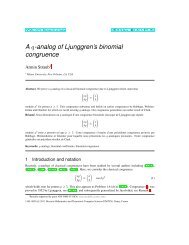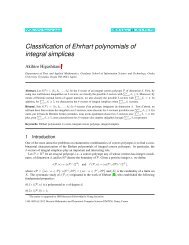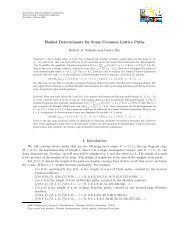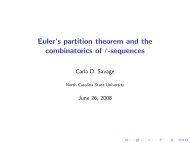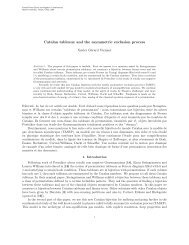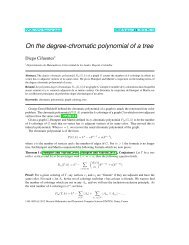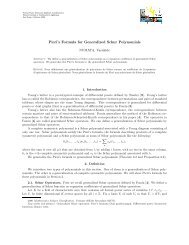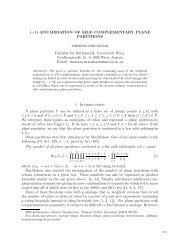Generalizations of Cauchy's Determinant and Schur's Pfaffian
Generalizations of Cauchy's Determinant and Schur's Pfaffian
Generalizations of Cauchy's Determinant and Schur's Pfaffian
Create successful ePaper yourself
Turn your PDF publications into a flip-book with our unique Google optimized e-Paper software.
<strong>Generalizations</strong> <strong>of</strong> Cauchy’s <strong>Determinant</strong> <strong>and</strong> Schur’s <strong>Pfaffian</strong><br />
Masao Ishikawa ∗ Soichi Okada † Hiroyuki Tagawa ‡ Jiang Zeng §<br />
Abstract<br />
We present several generalizations <strong>of</strong> Cauchy’s determinant det (1/(x i + y j)) <strong>and</strong> Schur’s<br />
<strong>Pfaffian</strong> Pf ((x j − x i )/(x j + x i )) by considering matrices whose entries involve some generalized<br />
V<strong>and</strong>ermonde determinants. Special cases <strong>of</strong> our formulae include previous formulae due<br />
to S. Okada <strong>and</strong> T. Sundquist. As an application, we give a relation for the Littlewood–<br />
Richardson coefficients involving a rectangular partition.<br />
Résumé<br />
On présente plusieurs généralisations du déterminant de Cauchy det (1/(x i + y j )) et du <strong>Pfaffian</strong><br />
de Schur Pf ((x j − x i )/(x j + x i )) en considérant des matrices dont les coefficients impliquent<br />
des déterminants de V<strong>and</strong>ermonde généralisés. Des cas particuliers de nos formules<br />
contiennent celles obtenues précédemment par S. Okada et T. Sundquist. Comme une application,<br />
on donne une relation pour les coefficients de Littlewood–Richardson associés aux trois<br />
partitions dont une est de forme rectangle.<br />
1 Introduction<br />
Identities for determinants <strong>and</strong> <strong>Pfaffian</strong>s are <strong>of</strong> great interest in many branches <strong>of</strong> mathematics.<br />
Some people need relations among minors or sub<strong>Pfaffian</strong>s <strong>of</strong> a general matrix, others have to evaluate<br />
special determinants or <strong>Pfaffian</strong>s. In combinatorics <strong>and</strong> representation theory, an important<br />
role is played by Cauchy’s determinant identity [3]<br />
( 1<br />
det<br />
=<br />
x i + y j<br />
)1≤i,j≤n<br />
<strong>and</strong> Schur’s <strong>Pfaffian</strong> identity [20]<br />
(<br />
xj − x i<br />
Pf<br />
=<br />
x j + x i<br />
)1≤i,j≤2n<br />
∏<br />
∏<br />
1≤i
M. ISHIKAWA, S. OKADA, H. TAGAWA, J. ZENG<br />
(<br />
If q = 0, then V n,0 (x; a) =<br />
x j−1<br />
i<br />
)<br />
<strong>and</strong> the determinant det V n,0 (x; a) = ∏ 1≤i
GENERALIZATIONS OF CAUCHY'S DETERMINANT AND SCHUR'S PFAFFIAN<br />
These identities were conjectured by S. Okada in [18].<br />
p = q = r = s = 0 in (1.4), then the identities read<br />
If we put p = q = 0 in (1.3) or<br />
(<br />
bj − a i<br />
det<br />
y j − x i<br />
)1≤i,j≤n<br />
( (aj − a i )(b j − b i )<br />
Pf<br />
=<br />
x j − x i<br />
)1≤i,j≤2n<br />
= ∏ (−1)n(n−1)/2<br />
n<br />
i,j=1 (y j − x i ) det V n,n (x, y; a, b), (1.7)<br />
1<br />
∏1≤i
M. ISHIKAWA, S. OKADA, H. TAGAWA, J. ZENG<br />
(2) If A is a skew-symmetric matrix, then we have<br />
Pf A 1,2<br />
1,2 · Pf A3,4<br />
− Pf A1,3<br />
· Pf A2,4<br />
+ Pf A1,4<br />
· Pf A2,3<br />
= Pf A · Pf A1,2,3,4<br />
. (2.2)<br />
This <strong>Pfaffian</strong> analogue <strong>of</strong> Desnanot–Jacobi formula is given in [9], [8], <strong>and</strong> is called the Plücker<br />
relation in [8].<br />
By applying Desnanot–Jacobi formula for <strong>Pfaffian</strong>s to the skew-symmetric matrix on the left<br />
h<strong>and</strong> side <strong>of</strong> (1.4) <strong>and</strong> using the induction on n, we can see that the pro<strong>of</strong> <strong>of</strong> (1.4) is reduced to<br />
the case n = 2 with z, c, w, d replaced by<br />
z ← (x (1,2,3,4) , z), c ← (a (1,2,3,4) , c), w ← (x (1,2,3,4) , w), d ← (b (1,2,3,4) , d),<br />
respectively, where x (1,2,3,4) denotes the vector obtained by removing x 1 , x 2 , x 3 , x 4 from x. Then<br />
the identity (1.4) in the case n = 2 can be proven by the induction on p + q + r + s with the help<br />
<strong>of</strong> the following relations between det V p,q <strong>and</strong> det V p−1,q (or det V q,p ).<br />
Lemma 2.2.<br />
(1) If p ≥ q <strong>and</strong> p ≥ 1, then we have<br />
det V p,q (x; a) =<br />
where we put<br />
∏<br />
p+q−1<br />
i=1<br />
(2) For nonnegative integers p <strong>and</strong> q, we have<br />
where a −1 = (a −1<br />
1 , · · · , a−1 p+q).<br />
(x p+q − x i ) · det V p−1,q (x 1 , · · · , x p+q−1 ; a ′ 1, · · · , a ′ p+q−1), (2.3)<br />
a ′ i = a i − a p+q<br />
x i − x p+q<br />
(1 ≤ i ≤ p + q − 1).<br />
p+q<br />
∏<br />
det V p,q (x; a) = (−1) pq a i · det V q,p (x; a −1 ), (2.4)<br />
Remark 2.3. We can also reduce the pro<strong>of</strong> <strong>of</strong> the other identities (1.3), (1.5) <strong>and</strong> (1.6) in Theorem<br />
1.1 to the case <strong>of</strong> n = 2 by using Desnanot-Jacobi formulae. It is easy to show the case <strong>of</strong><br />
n = 2 <strong>of</strong> (1.3) by using the relations in Lemma 2.2 <strong>and</strong> the induction on p + q. We can prove<br />
(1.5) (resp. (1.6)) in the case <strong>of</strong> n = 2, by regarding the both sides as polynomials in z p+q (resp.<br />
z p ) <strong>and</strong> showing that the values coincide at appropriate points by a brute force. Also the special<br />
cases <strong>of</strong> these identities can be obtained by regarding the both sides as meromorphic functions <strong>and</strong><br />
computing the principal parts at their poles.<br />
2.2 Homogeneous version <strong>and</strong> pro<strong>of</strong> <strong>of</strong> (1.3), (1.5) <strong>and</strong> (1.6)<br />
For the second part <strong>of</strong> the pro<strong>of</strong>, we introduce a homogeneous version <strong>of</strong> the matrix V p,q ( (x; a). )<br />
x a<br />
For vectors x, y, a, b <strong>of</strong> length n <strong>and</strong> nonnegative integers p, q with p+q = n, we set U p,q y b<br />
to be the n × n matrix with ith row<br />
(a i x p−1<br />
i<br />
, a i x p−2<br />
i<br />
y i , · · · , a i y p−1<br />
i<br />
i=1<br />
, b i x q−1<br />
i<br />
, b i x q−2<br />
i y i , · · · , b i y q−1<br />
i ).<br />
Then we have the following relation among det U p,q , det V p,q <strong>and</strong> det W p . Here use the following<br />
notation for vectors x = (x 1 , · · · , x n ) <strong>and</strong> y = (y 1 , · · · , y n ):<br />
<strong>and</strong>, for integers k <strong>and</strong> l,<br />
x + y = (x 1 + y 1 , . . . , x n + y n ), xy = (x 1 y 1 , . . . , x n y n ),<br />
x k = (x k 1, . . . , x k n),<br />
x k y l = (x k 1y l 1, . . . , x k ny l n).<br />
234
GENERALIZATIONS OF CAUCHY'S DETERMINANT AND SCHUR'S PFAFFIAN<br />
Lemma 2.4.<br />
(<br />
U p,q x<br />
y<br />
) p+q<br />
a ∏<br />
= a<br />
b<br />
k x p−1<br />
k<br />
· V p,q ( x −1 y; a −1 bx q−p) , (2.5)<br />
k=1<br />
( )<br />
V p,q (x; a) = U p,q 1 1<br />
, (2.6)<br />
x a<br />
)<br />
= (−1) n(n−1)/2 det W 2n (x; a), (2.7)<br />
)<br />
= (−1) n(n−1)/2 det W 2n+1 (x; a), (2.8)<br />
det U n,n (<br />
x 1 + ax<br />
1 + x 2 x + a<br />
det U n,n+1 (<br />
x 1 + ax<br />
2<br />
1 + x 2 1 + a<br />
where 1 = (1, · · · , 1).<br />
We can “homogenize” the identity (1.4).<br />
theorem is equivalent to (1.4).<br />
It follows from (2.5) <strong>and</strong> (2.6) that the following<br />
Theorem 2.5. Let n be a positive integer <strong>and</strong> let p, q, r <strong>and</strong> s be nonnegative integers. Suppose<br />
that the vectors x, y, a, b, c, d have length 2n, the vectors ξ, η, α, β have length p + q, <strong>and</strong> the<br />
vectors ζ, ω, γ, δ have length r + s. Then we have<br />
⎛<br />
( )<br />
( ) ⎞<br />
det U p+1,q+1 xi , x j , ξ a i , a j , α<br />
det U<br />
Pf ⎜<br />
y i , y j , η b i , b j , β<br />
r+1,s+1 xi , x j , ζ c i , c j , γ<br />
y i , y j , ω d i , d j , δ<br />
⎝<br />
( )<br />
⎟<br />
xi x<br />
det j<br />
⎠<br />
y i y j<br />
( ) n−1 (<br />
1<br />
=<br />
( ) det U p,q ξ α<br />
det U r,s ζ γ<br />
∏1≤i
M. ISHIKAWA, S. OKADA, H. TAGAWA, J. ZENG<br />
Now the identity (1.3) follows from this corollary (2.11), (2.6) <strong>and</strong> an appropriate replacement<br />
<strong>of</strong> variables. Also the remaining identities (1.5) <strong>and</strong> (1.6) are immediate from (2.11) <strong>and</strong> (2.9) by<br />
using the relations (2.7) <strong>and</strong> (2.8). This completes the pro<strong>of</strong> <strong>of</strong> Theorem 1.1.<br />
3 A variation <strong>of</strong> the determinant <strong>and</strong> <strong>Pfaffian</strong> identities<br />
In this section, we give a variation <strong>of</strong> the identities in Theorem 1.1, which can be regarded as a<br />
generalization <strong>of</strong> an identity <strong>of</strong> T. Sundquist [23].<br />
Let n be a positive integer <strong>and</strong> let p <strong>and</strong> q be nonnegative integers with p + q = n. Let<br />
x = (x 1 , · · · , x n ) <strong>and</strong> a = (a 1 , · · · , a n ) be vectors <strong>of</strong> variables. For partitions λ <strong>and</strong> µ with<br />
l(λ) ≤ p <strong>and</strong> l(µ) ≤ q, we define a matrix V p,q<br />
λ,µ<br />
(x; a) to be the n × n matrix with ith row<br />
(x λp<br />
i<br />
, x λp−1+1<br />
i<br />
, x λp−2+2<br />
i , · · · , x λ1+p−1<br />
i , a i x µq<br />
i<br />
, a i x µq−1+1<br />
i<br />
, a i x µq−2+2<br />
i , · · · , a i x µ1+q−1<br />
i ).<br />
For example, if λ = µ = ∅, then we have V p,q<br />
∅,∅ (x; a) = V p,q (x; a). Let P n denote the set <strong>of</strong><br />
partitions λ with length ≤ n which are <strong>of</strong> the form λ = (α 1 , · · · , α r |α 1 + 1, · · · , α r + 1) in the<br />
Frobenius notation. We define<br />
∑<br />
F p,q (x; a) = (−1) (|λ|+|µ|)/2 det V p,q<br />
λ,µ<br />
(x; a).<br />
λ∈P p, µ∈P q<br />
The main result <strong>of</strong> this section is the following theorem.<br />
Theorem 3.1. (a) Let n be a positive integer <strong>and</strong> let p <strong>and</strong> q be nonnegative integers. For six<br />
vectors <strong>of</strong> variables<br />
x = (x 1 , · · · , x n ), y = (y 1 , · · · , y n ), z = (z 1 , · · · , z p+q ),<br />
a = (a 1 , · · · , a n ), b = (b 1 , · · · , b n ), c = (c 1 , · · · , c p+q ),<br />
we have<br />
( F p+1,q+1 )<br />
(x i , y j , z; a i , b j , c)<br />
det<br />
(y j − x i )(1 − x i y j )<br />
=<br />
1≤i,j≤n<br />
(−1) n(n−1)/2<br />
∏ n<br />
i,j=1 (y j − x i )(1 − x i y j ) F p,q (z; c) n−1 F n+p,n+q (x, y, z; a, b, c). (3.1)<br />
(b) Let n be a positive integer <strong>and</strong> let p, q, r, s be nonnegative integers. For seven vectors <strong>of</strong><br />
variables<br />
x = (x 1 , · · · , x 2n ), a = (a 1 , · · · , a 2n ), b = (b 1 , · · · , b 2n ),<br />
z = (z 1 , · · · , z p+q ), c = (c 1 , · · · , c p+q ),<br />
w = (w 1 , · · · , w r+s ), d = (d 1 , · · · , d r+s ),<br />
we have<br />
( F p+1,q+1 (x i , x j , z; a i , a j , c)F r+1,s+1 )<br />
(x i , x j , w; b i , b j , d)<br />
Pf<br />
(x j − x i )(1 − x i x j )<br />
=<br />
1≤i,j≤2n<br />
1<br />
∏1≤i
GENERALIZATIONS OF CAUCHY'S DETERMINANT AND SCHUR'S PFAFFIAN<br />
The key ingredient to prove Theorem 3.1 <strong>and</strong> Corollary 3.2 is the following relation between<br />
F p,q (x; a) <strong>and</strong> det V p,q (y; b).<br />
Proposition 3.3. We have<br />
F p,q (x; a) = (−1) (p 2)+( q 2) p+q ∏<br />
x p−1<br />
i · det V p,q (x + x −1 ; ax q−p ),<br />
i=1<br />
= (−1) (p 2)+( q 2) det U<br />
p,q<br />
( )<br />
x 1<br />
1 + x 2 . (3.4)<br />
a<br />
This proposition can be proven by the Cauchy-Binet formula <strong>and</strong> the computation <strong>of</strong> minors<br />
in the following lemma.<br />
Lemma 3.4. Let D r be the following r ×(2r −1) matrix with columns indexed by 0, 1, · · · , 2r −2:<br />
D r =<br />
⎛<br />
⎜<br />
⎝<br />
0 r − 2 r − 1 r 2r − 2<br />
1<br />
1 1<br />
. .. . . .<br />
1 1<br />
⎞<br />
⎟<br />
⎠ .<br />
Then the minor <strong>of</strong> D r corresponding to a partition λ is given by<br />
det ∆ [r]<br />
I(λ) (D r) =<br />
{<br />
(−1) r(r−1)/2+|λ|/2 if λ ∈ P r ,<br />
0 otherwise,<br />
where ∆ [r]<br />
I(λ) (D r) is the r × r submatrix <strong>of</strong> D r consisting <strong>of</strong> columns λ r , λ r−1 + 1, · · · , λ 1 + (r − 1).<br />
Concluding this section, we should remark that, in Theorem 3.1, we can replace F p,q (x; a) by<br />
the following alternatives:<br />
∑<br />
G p,q (x; a) = (−1) (|λ|+|µ|)/2 det V p,q<br />
λ,µ<br />
(x; a),<br />
λ∈Q p , µ∈Q q<br />
∑<br />
H p,q (x; a) = (−1) (|λ|+p(λ)+|µ|+p(µ))/2 det V p,q<br />
λ,µ<br />
(x; a),<br />
λ∈R p, µ∈R q<br />
where Q n (resp. R n ) is the set <strong>of</strong> partitions λ with length ≤ n which are <strong>of</strong> the form λ = (α + 1|α)<br />
(resp. λ = (α|α)) in the Frobenius notation. Then we obtain similar relations between G p,q (x; a),<br />
H p,q (x; a) <strong>and</strong> det V p,q (y; b).<br />
4 Another generalization <strong>of</strong> Cauchy’s determinant identity<br />
In this section, we give another type <strong>of</strong> generalized Cauchy’s determinant identities involving<br />
det V p,q <strong>and</strong> det W p . The following is the main result <strong>of</strong> this section:<br />
Theorem 4.1.<br />
(<br />
)<br />
1<br />
det<br />
det V p+1,q+1 (x i , y j , z; a i , b j , c)<br />
1≤i,j≤n<br />
∏<br />
= (−1)n(n−1)/2 1≤i
M. ISHIKAWA, S. OKADA, H. TAGAWA, J. ZENG<br />
If p = q = 0, then the identity (4.1) becomes<br />
( 1<br />
det<br />
=<br />
b j − a i<br />
)1≤i,j≤n<br />
∏ (−1)n(n−1)/2 1≤i
GENERALIZATIONS OF CAUCHY'S DETERMINANT AND SCHUR'S PFAFFIAN<br />
Pro<strong>of</strong>. The first identity (5.3) is obtained from (1.4) by putting p = q = r = s = 0 <strong>and</strong> a i = b i =<br />
x m i . The second identity (5.4) follows from the first one (5.3) <strong>and</strong> the composition <strong>of</strong> hyperpfaffians<br />
given in [14, Eq. (82)].<br />
6 Application to Littlewood–Richardson coefficients<br />
In this section, we use the <strong>Pfaffian</strong> identity (1.5) in Theorem 1.1 <strong>and</strong> the minor-summation formula<br />
[7] to derive a relation between Littlewood–Richardson coefficients.<br />
For three partitions λ, µ <strong>and</strong> ν, we denote by LR λ µ,ν the Littlewood-Richardson coefficient.<br />
These numbers LR λ µ,ν appear in the following expansions (see [15]) :<br />
s µ (X)s ν (X) = ∑ λ<br />
LR λ µ,ν s λ (X),<br />
s λ/µ (X) = ∑ ν<br />
LR λ µ,ν s ν (X),<br />
s λ (X, Y ) = ∑ µ,ν<br />
LR λ µ,ν s µ (X)s ν (Y ).<br />
We are concerned with the Littlewood–Richardson coefficients involving rectangular partitions.<br />
Let □(a, b) denote the partition whose Young diagram is the rectangle a × b, i.e.<br />
□(a, b) = (b a ) = (b, . . . , b).<br />
} {{ }<br />
a<br />
For a partition λ ⊂ □(a, b), we define λ † = λ † (a, b) by<br />
λ † i = b − λ a+1−i<br />
(1 ≤ i ≤ a).<br />
Okada [16] used the special case <strong>of</strong> the identities (1.3) <strong>and</strong> (1.4) (i.e., the case <strong>of</strong> p = q = 0 <strong>and</strong><br />
p = q = r = s = 0) to prove the following proposition. (This proposition is also derived by the<br />
combinatorial algorithm called Littlewood–Richardson rule.)<br />
Proposition 6.1. Let n be a positive integer <strong>and</strong> let e <strong>and</strong> f be nonnegative integers.<br />
(1) For partitions µ, ν, we have<br />
{<br />
LRµ,ν □(n,e) 1 if ν = µ † (n, e),<br />
=<br />
0 otherwise.<br />
(2) For a partition λ <strong>of</strong> length ≤ 2n, we have<br />
{<br />
LR λ 1 if λ n+1 ≤ min(e, f) <strong>and</strong> λ i + λ 2n+1−i = e + f (1 ≤ i ≤ n),<br />
□(n,e),□(n,f) =<br />
0 otherwise.<br />
(6.1)<br />
(6.2)<br />
The main result <strong>of</strong> this section is the following theorem, which generalizes (6.2). It would be<br />
interesting to find a bijective pro<strong>of</strong> <strong>of</strong> the equality (6.5).<br />
Theorem 6.2. Let n be a positive integer <strong>and</strong> let e <strong>and</strong> f be nonnegative integers. Let λ <strong>and</strong> µ<br />
be partitions such that λ ⊂ □(2n, e + f) <strong>and</strong> µ ⊂ □(n, e). Then we have<br />
(1) LR λ µ,□(n,f) = 0 unless<br />
λ n ≥ f <strong>and</strong> λ n+1 ≤ min(e, f). (6.3)<br />
(2) If λ satisfies the above condition (6.3) <strong>and</strong> we define two partitions α <strong>and</strong> β by<br />
α i = λ i − f, β i = e − λ 2n+1−i , (1 ≤ i ≤ n), (6.4)<br />
then we have<br />
LR λ µ,□(n,f) = LR β α,µ † (n,e) . (6.5)<br />
In particular, LR λ µ,□(n,f) = 0 unless α ⊂ β.<br />
239
M. ISHIKAWA, S. OKADA, H. TAGAWA, J. ZENG<br />
In particular, if µ = □(n, e) is a rectangle, then this theorem reduces to (6.2). If µ is a<br />
near-rectangle, then we have the following corollary by using Pieri’s rule [15, (5.16), (5.17)].<br />
Corollary 6.3. Suppose that a partitions λ ⊂ □(2n, e + f) satisfies the condition (6.3) in Theorem<br />
6.2. Define two partitions α <strong>and</strong> β by (6.4). Then we have<br />
{<br />
LR λ (e n−1 ,e−k),(f n ) = 1 if β/α is a horizontal strip <strong>of</strong> length k,<br />
0 otherwise,<br />
{<br />
LR λ (e n−k ,(e−1) k ),(f n ) = 1 if β/α is a vertical strip <strong>of</strong> length k,<br />
0 otherwise.<br />
In order to prove Theorem 6.2, we substitute<br />
a i = x e+p+n<br />
i , b i = x f+r+n<br />
i , c i = z e+p+n<br />
i , d i = w f+r+n<br />
i (6.6)<br />
in the <strong>Pfaffian</strong> identity (1.4). By the bi-determinant definition <strong>of</strong> Schur functions, we have<br />
{<br />
det V p,q (x; x k s □(q,k−p) (x)∆(x) if k ≥ p,<br />
) =<br />
0 if k < p,<br />
where ∆(x) = ∏ 1≤i
GENERALIZATIONS OF CAUCHY'S DETERMINANT AND SCHUR'S PFAFFIAN<br />
Here we recall the minor summation formula [7].<br />
Lemma 6.7. Let X be a 2n × N matrix <strong>and</strong> A be an N × N skew-symmetric matrix. Then we<br />
have<br />
∑<br />
Pf ∆ I I(A) det ∆ [2n]<br />
I<br />
(X) = Pf(XA t X),<br />
I<br />
where I runs over all 2n-element subsets <strong>of</strong> [N], <strong>and</strong> ∆ I J (M) denotes the submatrix <strong>of</strong> a matrix M<br />
obtained by picking up the rows indexed by I <strong>and</strong> the columns indexed by J.<br />
By applying this minor-summation formula, we obtain<br />
Proposition 6.8. Let B = (b ij ) 0≤i,j≤e+f+2n−1 be the skew-symmetric matrix, whose entries b ij<br />
are given in Lemma 6.6. Then, for a partition λ ⊂ □(2n, e + f), we have<br />
∑<br />
µ⊂□(n,e)<br />
ν⊂□(n,f)<br />
where I(λ) = {λ 2n , λ 2n−1 + 1, . . . , λ 2 + 2n − 2, λ 1 + 2n − 1}.<br />
Now we can finish the pro<strong>of</strong> <strong>of</strong> Theorem 6.2.<br />
LR λ µ,ν s µ (n,e)(z)s † ν (n,f)(w) = Pf ∆ I(λ)<br />
† I(λ)<br />
(B), (6.10)<br />
Pro<strong>of</strong> <strong>of</strong> Theorem 6.2. In the above argument, we take p ≥ n <strong>and</strong> r = 0. In this case, the<br />
variables w disappear <strong>and</strong> we see that<br />
{<br />
h (e+n−1)+(f+n−1)+1−k−l (z) if 0 ≤ k ≤ min(e + n − 1, f + n − 1) <strong>and</strong> l ≥ f + n − 1,<br />
b kl =<br />
0 otherwise<br />
<strong>and</strong> the equation (6.10) becomes<br />
∑<br />
µ⊂□(n,e)<br />
LR λ µ,□(n,f) s µ † (n,e)(z) = Pf ∆ I(λ)<br />
I(λ) (B).<br />
( )<br />
O C<br />
The skew-symmetric matrix B has the form B =<br />
− t with<br />
C O<br />
C = (h e+n−1−i−j (z)) 0≤i≤f+n−1,0≤j≤e+n−1<br />
.<br />
¿From the relation (2.10), we see that the sub<strong>Pfaffian</strong> Pf B I(λ) vanishes unless<br />
If these conditions are satisfied, then we have<br />
λ n+1 ≤ min(e, f), λ n ≥ f.<br />
Hence we have<br />
Pf B I(λ) = (−1) n(n−1)/2 det ( h βi −α n+1−j −i+(n+1−j)(z) ) 1≤i,j≤n<br />
= s β/α (z).<br />
∑<br />
µ⊂□(n,e)<br />
LR λ µ,□(n,f) s µ † (n,e)(z) = s β/α (z).<br />
Comparing the coefficients <strong>of</strong> s µ † (n,e)(z) completes the pro<strong>of</strong>.<br />
References<br />
[1] A. I. Barvinok, New algorithms for linear k-matroid intersection <strong>and</strong> matroid k-parity problems,<br />
Math. Program. 69 (1995), 449–470.<br />
[2] D. M. Bressoud, “Pro<strong>of</strong>s <strong>and</strong> Confirmations : The Story <strong>of</strong> the Alternating Sign Matrix<br />
Conjecture”, Cambridge Univ. Press, 1999.<br />
241
M. ISHIKAWA, S. OKADA, H. TAGAWA, J. ZENG<br />
[3] A. L. Cauchy, Mémoire sur les fonctions alternées et sur les sommes alternées, Exercices Anal.<br />
et Phys. Math. 2 (1841), 151–159.<br />
[4] G. Frobenius, Über die elliptischen Funktionen zweiter Art, J. Reine und Angew. Math. 93<br />
(1882), 53–68.<br />
[5] M. Ishikawa, Minor summation formula <strong>and</strong> a pro<strong>of</strong> <strong>of</strong> Stanley’s open problem,<br />
arXiv:math.CO/0408204.<br />
[6] M. Ishikawa, S. Okada, H. Tagawa <strong>and</strong> J. Zeng <strong>Generalizations</strong> <strong>of</strong> Cauchy’s determinant <strong>and</strong><br />
Schur’s <strong>Pfaffian</strong>”, arXiv:math.CO/0411280.<br />
[7] M. Ishikawa <strong>and</strong> M. Wakayama, Minor summation formulas <strong>of</strong> <strong>Pfaffian</strong>s, Linear <strong>and</strong> Multilinear<br />
Algebra 39 (1995), 285–305.<br />
[8] M. Ishikawa <strong>and</strong> M. Wakayama, Applications <strong>of</strong> the minor summation formula III: Plücker<br />
relations, lattice paths <strong>and</strong> <strong>Pfaffian</strong>s, arXiv:math.CO/0312358.<br />
[9] D. Knuth, Overlapping <strong>Pfaffian</strong>s, Electron. J. Combin. 3 (2) (“The Foata Festschrift”) (1996),<br />
151–163.<br />
[10] C. Krattenthaler, Advanced determinant calculus, Sem. Lothar. Combin. 42 (1999), B42q.<br />
[11] C. Krattenthaler, Advanced determinant calculus : a complement, arXiv:math.CO/0503507.<br />
[12] D. Laksov, A. Lascoux <strong>and</strong> A. Thorup, On Giambelli’s theorem on complete correlations,<br />
Acta Math. 162 (1989), 143–199.<br />
[13] A. Lascoux, Symmetric Functions <strong>and</strong> Combinatorial Operators on Polynomials, CBMS Reg.<br />
Conf. Ser. Math. 99, AMS, 2003.<br />
[14] J.-G. Luque <strong>and</strong> J.-Y. Thibon, <strong>Pfaffian</strong> <strong>and</strong> Hafnian identities in shuffle algebras, Adv. Appl.<br />
Math. 29 (2002), 620–646.<br />
[15] I. G. Macdonald, “Symmetric Functions <strong>and</strong> Hall Polynomials (2nd ed.),”Oxford Univ. Press,<br />
1995.<br />
[16] S. Okada, Applications <strong>of</strong> minor-summation formulas to rectangular-shaped representations<br />
<strong>of</strong> classical groups, J. Alg. 205 (1998), 337–367.<br />
[17] S. Okada, Enumeration <strong>of</strong> symmetry classes <strong>of</strong> alternating sign matrices <strong>and</strong> characters <strong>of</strong><br />
classical groups, arXiv:math.CO/0408234.<br />
[18] S. Okada, <strong>Determinant</strong> <strong>and</strong> <strong>Pfaffian</strong> formulae <strong>of</strong> Cauchy type <strong>and</strong> their applications, in<br />
“Aspects <strong>of</strong> Combinatorial Representation Theory,” Sūrikaisekikenkyūsho Kōkyūroku 1382<br />
(2004), 198–215 (in Japanese).<br />
[19] S. Okada, An elliptic generalization <strong>of</strong> Schur’s <strong>Pfaffian</strong> identity, arXiv:math.CA/0412038.<br />
[20] I. Schur, Über die Darstellung der symmetrischen und der alternirenden Gruppe durch gebrochene<br />
lineare Substitutionen, J. Reine Angew. Math. 139 (1911), 155–250.<br />
[21] R. P. Stanley, Open problem, presented at International Conference on Formal Power Series<br />
<strong>and</strong> Algebraic Combinatorics (Vadstena 2003), June 23 – 27, 2003, available from<br />
http://www-math.mit.edu/ rstan/trans.html.<br />
[22] J. R. Stembridge, Non-intersecting paths, <strong>Pfaffian</strong>s <strong>and</strong> plane partitions, Adv. Math. 83<br />
(1990), 96–131.<br />
[23] T. Sundquist, Two variable <strong>Pfaffian</strong> identities <strong>and</strong> symmetric functions, J. Algebraic Combin.<br />
5 (1996), 135–148.<br />
242



